If you are looking for a new nickel to add to your coin collection, you would be happy to include the 1975 nickel.
What is the 1975 nickel? What is its value, historical background, and composition? Most importantly, is it worth having?
What Is the 1975 Jefferson Nickel Made Of?
The 1975 Jefferson nickel is made of 75% copper and 25% nickel. However, from mid-1942 to 1945, the nickels were changed to 56% copper, 35% silver, and 9% manganese. This was done to ensure the United States had enough nickel supply to last them during the war.
The 1975 nickel has a value of 5 cents. In terms of size, the mass is 5 grams, and the diameter is 21.21 millimeters. The edge is plain.
As its name suggests, the 1975 Jefferson nickel features the face of the third US president, Thomas Jefferson. Felix Schlag designed the coin, and it was first struck in 1938.
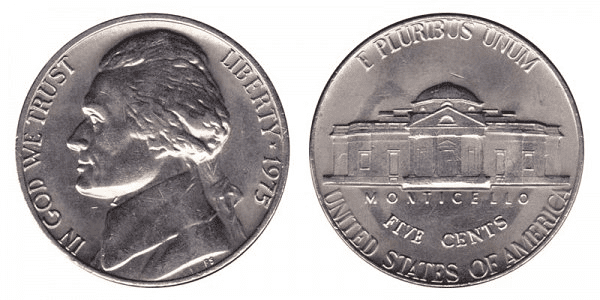
The design of the 1975 nickel is essentially the same as that of other Jefferson nickels struck from 1938 to 2004. So, on the obverse, you have the left profile of Jefferson with the inscriptions that include IN GOD WE TRUST, LIBERTY, 1975, JS, and mint mark (if present).
On the reverse, you have the front view of the Monticello, a mansion located in Charlottesville, Virginia. Inscriptions include E PLURIBUS UNUM, MONTICELLO, FIVE CENTS, and UNITED STATES OF AMERICA.
The Jefferson nickel replaced the Buffalo nickel. Although the Buffalo nickel features a nice and beautiful design, it was difficult to mint. Its die easily broke. So, once the Buffalo nickel could legally be replaced after 25 years, the US Mint moved immediately to find a new design.
In January 1938, the US Mint announced they would have a design competition for the new nickel. They required that the design include Jefferson on the obverse and the Monticello, Jefferson’s mansion, to be on the reverse. The winner would take home $1,000, a huge amount.
Initially, only a few submitted their design. However, when the submission deadline was almost at hand, more and more artists moved forward to bring their entries. Eventually, Schlag, a German-born American sculptor, won the competition. His design would then be used from 1938 to 2004.
In 2005, the new design by Joe Fitzgerald was used, but still, it is an image of Jefferson. His design won’t last long because in 2005, Jamie Franki’s design, where Jefferson faces forward, would be used. As this might be the case, Schlag’s reverse design is still being used until this day.
1975 Jefferson Nickel Varieties
There are three varieties of the 1975 Jefferson nickel. These varieties differ in terms of whether they are proof coins or not. They also differ based on their mint marks.
Here’s a quick look at the varieties and their mintage:
| Variety | Mint Location | Mintage |
| 1975 P Jefferson Nickel | Philadelphia | 181,772,000 |
| 1975 D Jefferson Nickel | Denver | 401,875,300 |
| 1975 S Proof Jefferson Nickel | San Francisco | 2,845,450 |
| Total | 586,492,750 |
As you can see, the Philadelphia, Denver, and San Francisco Mint worked together to produce more than 586 million nickels in 1975. The San Francisco Mint focused on producing proof coins, while the other mints worked to produce regular coins for circulation.
The mintage figure for 1975 is lower than that for 1974 and 1976. Due to the high mintage figure of 1974, the US Mint needed to lower production in 1975 to be commensurate with the current demand.
Let’s now take a deeper look at the 1975 Jefferson nickel varieties:
1975 P Jefferson Nickel
Year of minting: 1975
Mint Mark: none
Place of minting: Philadelphia
Quantity produced: 181,772,000
Face Value: $0.05 (five cents)
Price: $0.10 to $0.20 (circulated condition)
Mass: 5.00 grams
Diameter: 21.20 mm
Edge: Plain
Designer: Felix Schlag
Composition: 75% Copper, 25% Nickel

The Philadelphia Mint produced more than 181 million nickels in 1975. This made the 1975-P nickel very common. You should easily find one in circulation. They become scarce when they reach grades from MS67 and above. Any 1975-P nickel with at least a grade of MS66 Full Steps designation is rare.
1975 D Jefferson Nickel
Year of minting: 1975
Mint Mark: D
Place of minting: Denver
Quantity produced: 401,875,300
Face Value: $0.05 (five cents)
Price: $0.10 to $0.20 (circulated condition)
Mass: 5.00 grams
Diameter: 21.20 mm
Edge: Plain
Designer: Felix Schlag
Composition: 75% Copper, 25% Nickel
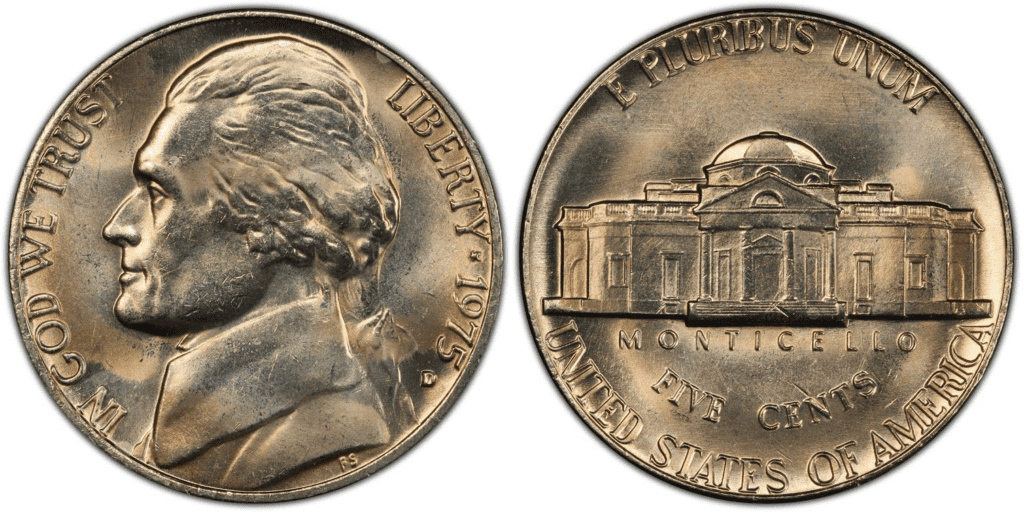
With more than 401 million nickels produced, the Denver Mint has the highest production of 1975 nickels.
1975 S Proof Jefferson Nickel
Year of minting: 1975
Mint Mark: S
Place of minting: San Francisco
Quantity produced: 2,845,450
Face Value: $0.05 (five cents)
Price: $0.10 to $0.20 (circulated condition)
Mass: 5.00 grams
Diameter: 21.20 mm
Edge: Plain
Designer: Felix Schlag
Composition: 75% Copper, 25% Nickel
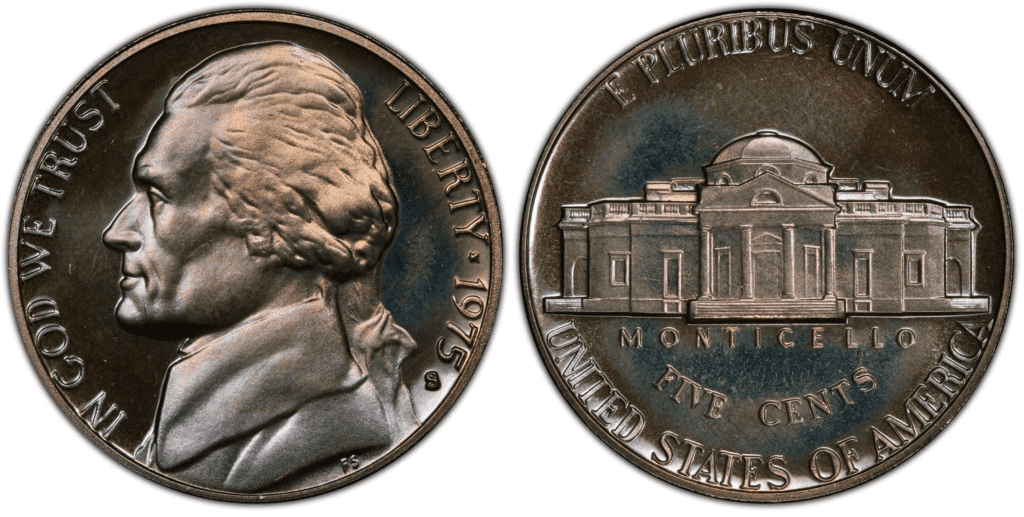
The San Francisco Mint produced more than 2.8 million proof nickels in 1975. With a mintage like this, the 1975-S proof coin should be easy to find up to grades of PR69. What is difficult to find is the 1975-S with a grade of PR70 and a rating of Deep Cameo.
List Of 1975 Jefferson Nickel Errors
The 1975 Jefferson nickel is not free of errors. The US Mint worked hard to ensure that every coin was perfectly made, but due to mechanical and sometimes human errors, there would still be coins that have errors in them.
As this might be the case, sometimes, error coins are the ones with the highest value. Take a look at the following error coins of 1975 nickel to learn more:
Mint mark errors
Mint mark errors may be caused by the mintmark being punched twice on the coin. Sometimes, the punch is so weak that the mintmark looks like a blob. Here’s an example:
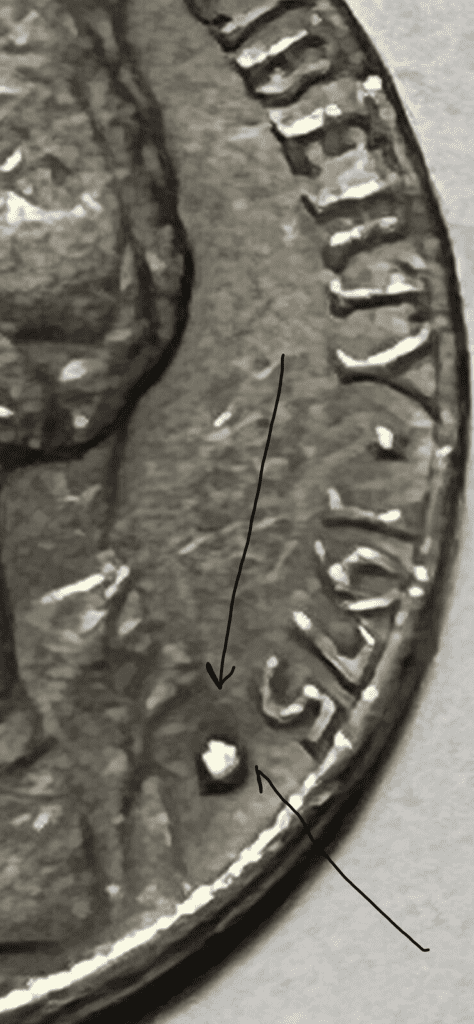
There are also instances when the mintmark becomes filled, just like this one:
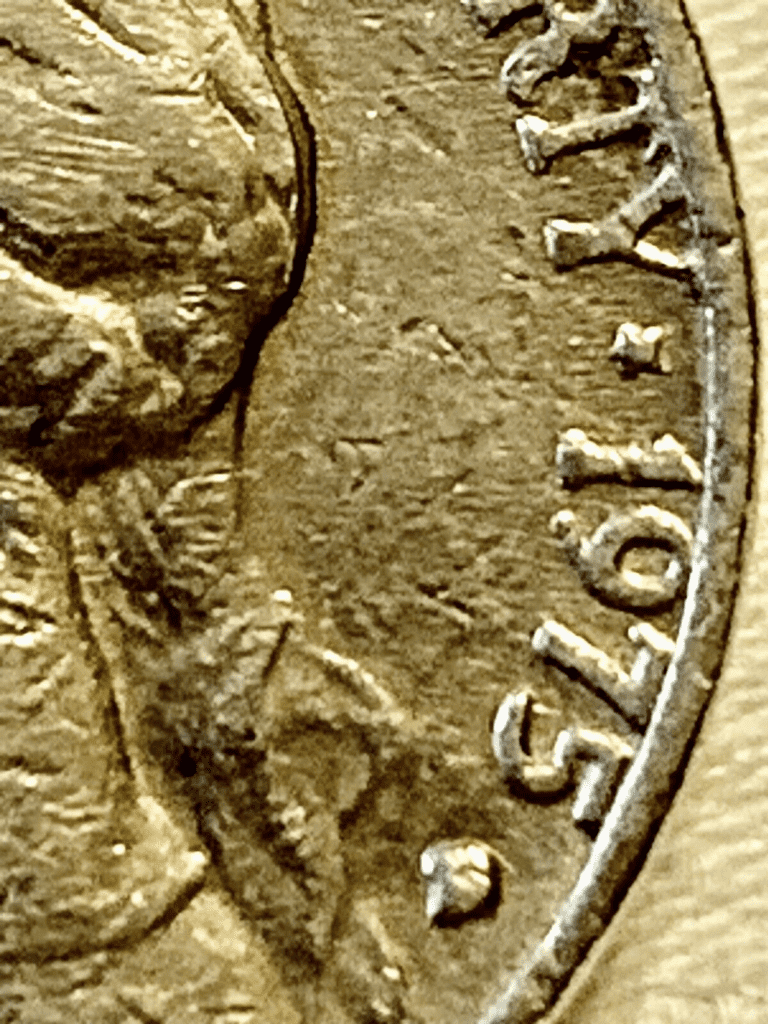
Another example is when the mintmark is placed too high from its original intended place. Check out this image:
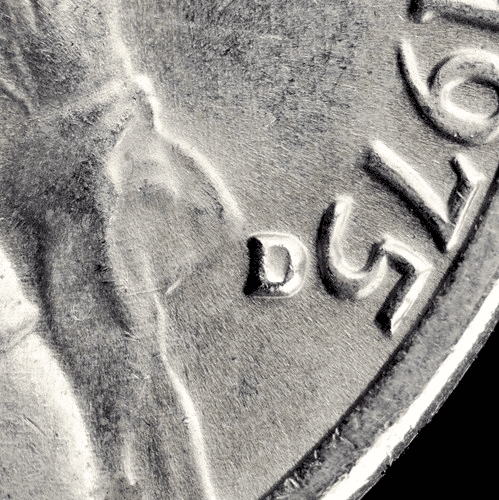
Clipped planchet
While cutting the coin, the machine misfeeds the metal sheet to the coin-cutting equipment. As a result, there’s a misalignment, and the coin gets clipped.
Here’s an example:
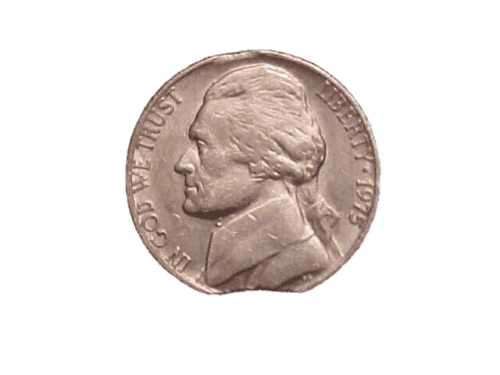
Doubled die error
The doubled die error happens when the die hits the planchet twice. If the second strike were hit on a different angle, you’d find a doubling on the letters, images, or numbers.
Here’s an example:
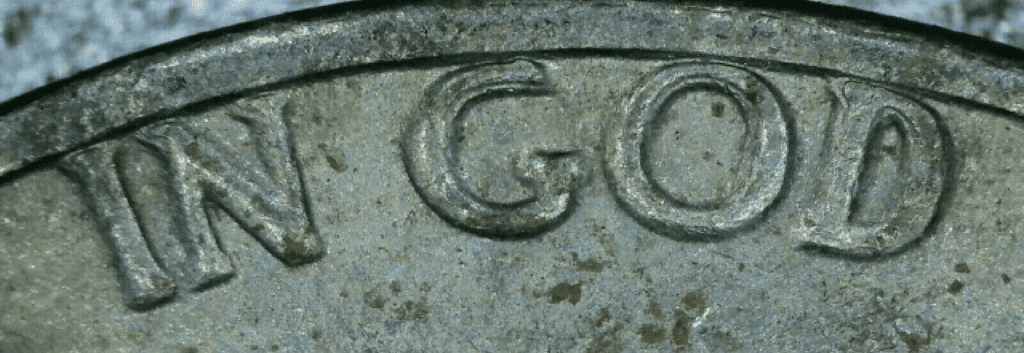
How Much Is 1975 Jefferson Nickel Worth Today?
The 1975 Jefferson nickel is affordable if you base its value on its face and melt values. The face value is 5 cents, and the melt value is $0.0639. The price of a circulated 1975 nickel is less than $1.
Nevertheless, 1975 Jefferson nickels are just way too expensive. Take a look at this table of auction records to see their value:
| Coin | Condition | Grade | Sold date | Sold by | Value |
| 1975 D Jefferson Nickel | Superb Gem Uncirculated | MS 67+ – Full Steps | August 25, 2021 | Stack’s Bowers | $4,560 |
| 1975 P Jefferson Nickel | Extremely Fine | XF 40 | May 8, 2022 | Heritage Auctions | $1,080 |
| 1975 S Proof Jefferson Nickel | Perfect Uncirculated | PR 70 – Deep Cameo | January 7, 2015 | Heritage Auctions | $5,640 |
How Does The Grading System Work?
Coin grading is the process of determining and evaluating the quality and condition of the coin by looking at its surface, level of preservation, and quality of strike. The same standards and process are used when grading a coin, including the 1975 nickel.
Professional numismatists joined in the 1970s and established CoinGrading standards, known as the Sheldon Scale. These numismatists now assign grades at key places on the seventy-point scale, using the most regularly utilized numeric points in conjunction with the original adjective grade. The following are the most common coin grades:
- (P-1) Poor – Indistinguishable and probably damaged; if used, must have a date and mintmark; otherwise, rather battered.
- (FR-2) Fair – Nearly smooth, but without the damage that a coin graded Poor often possesses. The coin must have enough detail to be identified.
- (G-4) Fair – Inscriptions have merged into the rims in some areas, and important elements have been mostly erased.
- (VG-8) Very Good- A little weathered, but all primary design elements are visible, albeit faintly. There is little, if any, central detail left.
- (F-12) Good – The item is very worn, yet the wear is even, and the overall design details stand out clearly. Rims are almost completely isolated from the field.
- (VF-20) Very Fine – Moderately weathered, with some finer features still visible. The motto or all letters of LIBERTY are readable. Both sides of the coin have entire rims separated from the field.
- (EF-40) Extremely Fine – Gently used; all gadgets are visible, and the most important ones are bold. The finer details are bold and clear; however, light wear may be seen.
- (AU-50) Uncirculated – Slight evidence of wear on the coin’s design’s high points; it may have contact marks; eye appeal should be adequate.
- (AU-58) Uncirculated Choice – Slight traces of wear, no severe contact marks, almost full mint shine, and great eye appeal.
- (MS-60) Mint State Basal – Strictly uncirculated; no indication of wear on the coin’s highest points, but an unsightly coin with reduced luster, visible contact marks, hairlines, and other flaws.
- (MS-63) Mint State Acceptable – Uncirculated, but with contact scratches and nicks, little reduced shine, but otherwise appealing appearance. The strike is weak to average.
- (MS-65) Mint State Choice – Uncirculated with great mint shine, little contact blemishes, and exceptional eye appeal. The strike is unusually severe.
- (MS-68) Mint State Premium Quality – Uncirculated with superb luster, no obvious contact marks to the naked eye, and exceptional eye appeal. The strike is quick and appealing.
- (MS-69) Almost Perfect Mint State – Uncirculated with perfect brilliance, a sharp and appealing strike, and extremely good eye appeal. A near-perfect coin with minor imperfections in the planchet, strike, and contact markings (seen only under 8x magnification).
- (MS-70) Mint State Perfect – Under 8x magnification, no tiny imperfections are discernible; the strike is crisp, and the coin is perfectly centered on a beautiful planchet. Rarely seen on a coin, this coin is bright and whole, with original luster and exceptional eye appeal.
The 1975 Jefferson nickel would also be evaluated based on the number of visible steps found on the Monticello. It is called a “Full Steps” nickel if there are at least five distinguishable steps.
Where To Buy Or Sell 1975 Jefferson Nickel?
The 1975 Jefferson nickel is available on the Internet. Some of the websites you can go to include the following:
- eBay
- Amazon
- Etsy
- USA Coin Book
- Coin Appraiser
- Grey Sheet
- JM Bullion
Aside from the Internet, you can go to coin shops, antique stores, and pawnshops. You can also join auctions where some of the rarest coins are found.
FAQs
Where is the mint mark on a 1975 nickel?
The mint mark on a 1975 nickel is found on the obverse side of the coin. You should find it just below the number 5 of the year 1975. If present, the mint mark can either be D or S.
Is a 1975 nickel rare?
No, the regular 1975 nickel isn’t rare. However, 1975 nickels with at least a grade of MS67 and a Full Steps designation are considered rare since only a few survive.
1974 Lincoln Penny Value Guide (Incld. Rare Varieties)
1974 Kennedy Half Dollar Value Guide (Incld. Rare Varieties)
1975 Quarter Value Guide (Incld. Rare Varieties)
1975 Dime Value Guide (Incld. Rare Varieties)
1976 Quarter Value Guide
1976 Dollar Coin Value Guide (Incld. Rare Varieties)
1976 2 Dollar Value Guide (Incld. Rare Varieties)
